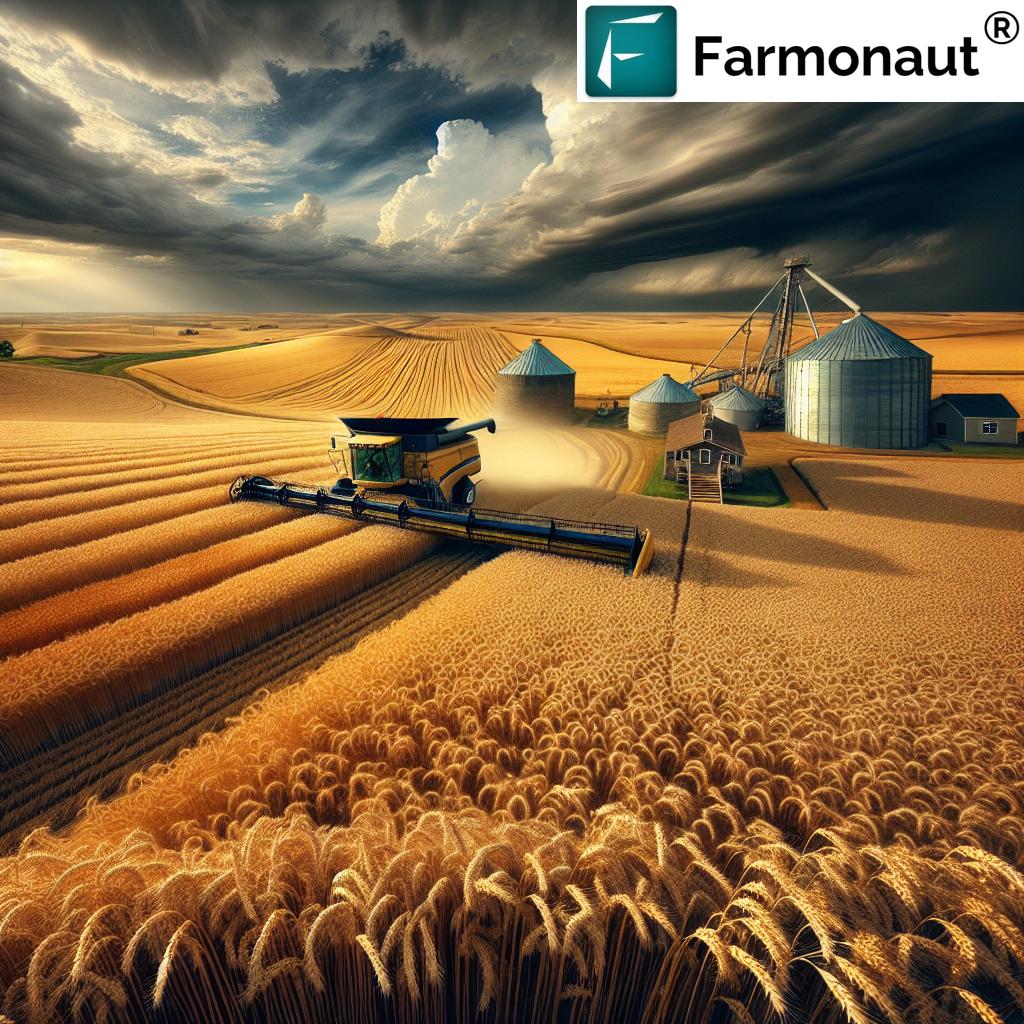“Over 3 semi-trucks were destroyed in the Arrowwood Prairie fertilizer facility fire, impacting local agricultural logistics.”
Wimbledon Rural Fire: 3 Semis Destroyed at Arrowwood Prairie Facility
Location: Wimbledon, North Dakota
Date of Incident: Late Thursday night, [Refer to Latest Local News for Date]
Incident: Arrowwood Prairie fertilizer facility fire; three semis and another truck destroyed in parking lot
The Wimbledon rural fire department, alongside supporting units from Dazey, Courtenay, and Valley City, responded to a massive blaze at the Arrowwood Prairie Fertilizer facility in Wimbledon, North Dakota. This industrial-scale fire resulted in the destruction of three semi-trucks and extensive damage to another vehicle—substantially impacting the facility’s logistics infrastructure.
In this comprehensive analysis, we provide precise details about the incident timeline, emergency fire response, the impact on agricultural operations, emergency management best practices, and how advanced agritech tools like Farmonaut contribute to long-term risk reduction and operational resilience across the rural and agricultural sectors.
Arrowwood Prairie Fertilizer Facility Fire Wimbledon: Timeline & Impact
Key focus keywords: Arrowwood Prairie Fertilizer Facility, fertilizer facility fire Wimbledon, semi truck fire parking lot, Wimbledon rural fire department, rural fire department North Dakota.
How Did the Arrowwood Prairie Fire Unfold?
- Time of Call: Late Thursday night, emergency services received reports about a semi-truck fire in the parking lot at Arrowwood Prairie Facility in Wimbledon.
- Initial Observations: Upon arrival, the Wimbledon Rural Fire Department found three semis and an additional truck burning; the trailers, crucially, did not contain active chemicals or fertilizer products at the time.
- Fire Suppression: Firefighters used specialized water and foam techniques to contain and suppress the flames—mirroring best practices for industrial vehicle fires.
- Outcome: Three of the four trucks were declared total losses. Despite significant property damage, no injuries were reported.
- Cause: The fire’s origin remains under active investigation by local authorities.
This fire not only disrupted local operations at the fertilizer facility but also exposed vulnerabilities in agricultural logistics and underscored the critical necessity of emergency preparedness in industrial parking lots.
Why Rural Fire Incidents Demand Special Attention
We must emphasize that a fire incident at a rural fertilizer facility like Arrowwood Prairie affects not just direct stakeholders but also the agricultural supply chain, local communities, and overall regional resilience.
- Major equipment losses (such as semis and truck trailers) can severely delay fertilizer delivery, impacting crop cycles and the local farming economy.
- Fortunately, no stored chemicals or fertilizer were ignited, averting a much larger crisis.
- The Wimbledon rural fire department, along with Dazey Courtenay Valley City fire response units, showcased exemplary operational coordination, crucial in rural settings where resources may be limited and distances long.
This incident serves as a serious reminder for every rural fire department in North Dakota and beyond about the importance of continuous training, resource allocation, and adoption of modern risk mitigation technologies.
“Wimbledon Rural Fire Department deployed multiple units to contain a blaze that damaged several vehicles at an industry site.”
Wimbledon Rural Fire Department Response: Collaboration & Execution
As soon as reports of the semi truck fire parking lot reached dispatch, the Wimbledon rural fire department mobilized personnel and equipment, swiftly followed by Dazey, Courtenay, and Valley City Rural Fire Department teams.
- Rapid response prevented the flames from spreading to critical facility infrastructure or stored fertilizers and chemicals. This response involved:
- Deployment of multiple fire tenders equipped with water and foam
- Expert use of foam for smothering hydrocarbon-fueled fires (common in vehicle and truck fires)
- Acceleration of on-site decision-making in coordination with Arrowwood Prairie staff
- The rural setting meant response times and teamwork were crucial—each second saved prevented potentially millions in further damages and environmental risks.
- Post-incident, cool-down and monitoring activities ensured that any hot spots or reignitions were quickly suppressed.
We commend the rural fire department North Dakota teams for integrating emergency best practices, demonstrating why seamless regional cooperation is essential in large-scale agricultural and industrial incidents.
Incident Impact Summary Table: Arrowwood Prairie Fertilizer Facility Fire
| Item Affected | Estimated Quantity / Value Lost | Response Time (approx.) |
Fire Department Resources Deployed |
|---|---|---|---|
| Semi Trucks | 3 Total Loss ($400,000–$600,000 est.) |
15 min (Wimbledon FD) | 2 Units, 8 Personnel |
| Other Truck | 1 Damaged / Partial Loss | — | — |
| Facility Buildings | Unaffected (Quick Stop Contained) | — | — |
| Fire Equipment | Water, Foam Utilized | Supplemented by Dazey, Courtenay, Valley City | 3+ Trucks, 12+ Personnel (total on scene) |
All values are approximate and subject to official updates from the Wimbledon rural fire department and Arrowwood Prairie Facility management.
Inside the Scene: Fighter Response & Technology in Action
The following images and videos capture the immediate aftermath, the fire response action, and examples of technology integration for crisis management. Click any image to learn more about agricultural and fire resilience technology with Farmonaut.
Industrial Fire Incidents: Industry Trends & Lessons Learned
Every major incident, such as the fertilizer facility fire Wimbledon, is an opportunity for the entire agricultural industry to evaluate best practices, technological readiness, and future strategies for risk mitigation.
- Trucking & Logistics Loss: Semi-trucks and trailers are central to fertilizer distribution, delivery, and supply chain validation in Wimbledon, Dazey, Courtenay, and Valley City regions.
- Parking Lot Vulnerabilities: Facility parking lots often store critical transport and equipment resources outside core buildings—requiring proactive surveillance and emergency planning.
- Fertilizer and Chemicals: Rapid incident response limited any risk to stored fertilizer or chemical stockpiles, preventing hazardous air emissions or runoff.
- Emergency Coordination: Multi-jurisdictional response by Wimbledon rural fire department, Dazey, Courtenay, and Valley City emphasized the importance of regional communication networks.
- Foam & Water Usage: Combination of water and foam proved effective against vehicle fires, highlighting best practice for industrial fire events where combustibles and hydrocarbon residues are present.
The Broader Agricultural Impact in Rural North Dakota
- Fire incidents can quickly ripple out, delaying spring planting, disrupting planned fertilizer applications, and straining farm and facility finances.
- Supply shortfalls may negatively affect forecasting and pricing models across the North Dakota rural agriculture sector.
- Insurance policies, logistics partners, and farmers all benefit from transparent post-incident assessments—reinforcing the value of technology, real-time data, and precision tracking tools like those offered by Farmonaut.
How Farmonaut’s Technologies Empower Agricultural Fire and Risk Management
As a pioneering agricultural technology provider, we at Farmonaut understand the role of satellite and AI-driven tools in both daily farm management and long-term risk reduction at industrial facilities like Arrowwood Prairie.
- Satellite-Based Monitoring: By using our carbon footprinting and blockchain-based traceability tools, agricultural businesses can continuously audit their operational footprint and maintain transparent, tamper-proof records for compliance, insurance claims, and resource allocation—especially critical after facility fire incidents.
- Fleet Management Optimization: Our farm fleet management solution enables real-time vehicle monitoring, utilization tracking, and advanced analytics—allowing facilities to optimize routes, maintenance schedules, and risk mitigation. Should an emergency arise, facility managers can quickly ascertain asset locations for targeted protection.
- Large-Scale Farm Oversight: Through large scale farm management apps and our web platform, farm operators, facility owners, and fire safety officers can receive instant alerts, health indices, and weather risk analysis for informed action.
- AI Advisory and Emergency Decision Support: Tools like our Jeevn AI system ingest satellite weather and in-field data to generate actionable insights, helping prevent or rapidly respond to incidents—from fire to flood, drought, or pest outbreaks.
- APIs for Custom Integration: Our API and API Developer Docs make it seamless to integrate satellite and weather intelligence into internal facility or fire response dashboards.
We encourage all stakeholders in rural agriculture—in Wimbledon, Dazey, Courtenay, Valley City, or anywhere globally—to explore the Farmonaut App for holistic fire, fleet, and resource management solutions.
Improving Fire Readiness for Rural Facilities: Best Practices & Technology
- Facility Risk Mapping: Satellite maps and geotagged data allow for dynamic monitoring of parking lots, vehicle clusters, and storage zones—helping to identify risk hot-spots.
- Emergency Protocols Powered by Data: By integrating Farmonaut’s advisory and data layers, managers can track weather risks or equipment malfunctions that elevate fire hazards.
- Asset Traceability: Logging vehicle movements and storage times is vital for post-incident analysis. Using solutions available from Farmonaut Traceability, facility managers get audit-ready digital records.
- Insurance and Recovery: Many insurance providers accept satellite and blockchain-based assessment data as valid proof for claims, expediting recovery post-incident.
- Environmental Compliance & Reporting: Advanced carbon footprinting tools assist in meeting regulatory requirements, prevent environmental liabilities after accidental fertilizer or chemical fires.
Modern technology, implemented in daily operations, empowers agricultural facilities to minimize downtime, maximize safety, and continually seek operational improvements.
Discover Farmonaut: Apps, API, and Flexible Subscription Plans
Whether managing 10 or 10,000 hectares, Farmonaut delivers actionable insights for risk management, supply chain tracking, emergency readiness, and efficiency optimization. Our apps and APIs are designed for mobile, web, and integration into in-house platforms.
- Browse our crop plantation, forest, and advisory tools for instant access to health, weather, and resource status of your landholdings.
- Leverage Farmonaut’s crop loan and insurance verification modules—ideal post-incident, ensuring transparent, satellite-verified claims with ease.
- Explore our fleet management platform for maximizing efficiency, reducing losses, and responding faster during crises.
Frequently Asked Questions: Wimbledon Rural Fire & Farmonaut Solutions
What happened at the Arrowwood Prairie facility in Wimbledon?
The Arrowwood Prairie Fertilizer facility in Wimbledon, North Dakota, experienced a significant fire in its parking lot, destroying three semi-trucks and damaging another vehicle. Rural fire departments from Wimbledon, Dazey, Courtenay, and Valley City responded rapidly, using water and foam to contain the blaze. No injuries or chemical releases occurred.
How does a fertilizer facility fire impact local agriculture?
Such incidents disrupt fertilizer distribution, delay planting or application, strain logistics, and can create regional shortages. The loss of trucks/fleet in facility fires also increases operational expenses and insurance claims for both rural businesses and farmers.
What technology can help reduce risks for rural facilities?
Technology such as satellite crop monitoring, AI advisory systems, blockchain-based traceability, and carbon footprinting tools (as offered by Farmonaut) help facility operators continuously track assets, improve emergency response, ensure transparent reporting, and streamline recovery post-incident.
How can Farmonaut’s platform be accessed?
Farmonaut is available as an Android app, iOS app, web-browser platform, and API. Users can manage farms, monitor fleet, get advisory updates, and access emergency risk analysis from any device, anywhere. Check out the above app links for direct access.
What is the value of fleet management in agricultural fires?
Knowing the real-time location and condition of every vehicle—especially in parking lots and rural facilities—enables rapid intervention, loss prevention, and optimized emergency response. Farmonaut’s fleet management app adds this crucial layer to industrial settings.
Are Farmonaut’s solutions scalable for large and small operations?
Yes. Farmonaut’s suite is designed for scalability—whether for individual farmers, large agribusinesses, facility owners, or government entities—delivering value from a few fields to national networks.
Can Farmonaut’s data help with insurance and loan processes post-incident?
Absolutely. Satellite-based verification and transparent blockchain traceability expedite crop loan and insurance claims, providing third-party validation required by banks and insurers.
What other safety checklists can agricultural facilities adopt following a fire?
Facilities are encouraged to: conduct regular risk mapping, install updated surveillance in parking and vehicle storage lots, keep detailed asset logs, regularly test suppression systems, and integrate remote monitoring technologies like Farmonaut’s app platform.
Conclusion: Building Resilient Rural Facilities with Innovation
The Arrowwood Prairie Fertilizer facility fire in Wimbledon underscores the unpredictable, high-stakes risks inherent in rural industrial and agricultural operations. Fast, coordinated action by Wimbledon rural fire department and neighbors from Dazey, Courtenay, and Valley City averted even greater disaster—but the event is a call to action for all facility operators.
Integrating modern satellite, AI, and digital fleet management tools—like those from Farmonaut—offers scalable, affordable, and powerful ways to track facility health, secure valuable assets, and ensure regulatory and insurance compliance.
We encourage all agricultural and industrial facility stakeholders to explore Farmonaut’s app and web platform for daily operations and robust emergency preparedness in Wimbledon, North Dakota, and beyond.


















